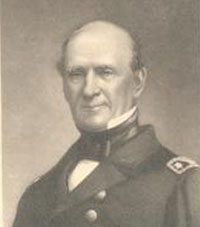Silas Horton Stringham (1798-1876)
Silas Horton Stringham, naval officer, was born in Middletown, Orange County, New York, on November 7, 1798. He died in Brooklyn, New York, 7 February, 1876.
 He entered the navy as a midshipman on November 15, 1809, and in the frigate President participated in the engagements with the Little Belt and Belvidere. He was commissioned lieutenant, on December 9, 1814, and served in the schooner Spark in the Mediterranean in 1815-18, participating in the Algerine war. During a storm at Gibraltar, upon one occasion, he went in a boat with six men to rescue the crew of a French brig that had capsized. He succeeded in getting the crew, but was unable to get back to port, and was blown off to Algesiras, where his boat capsized in the surf on the beach, and one of his crew and two Frenchmen were drowned. In 1819-21 he served in the sloop Cyane on the coast of Africa, and brought home four slavers as prize-master.
He entered the navy as a midshipman on November 15, 1809, and in the frigate President participated in the engagements with the Little Belt and Belvidere. He was commissioned lieutenant, on December 9, 1814, and served in the schooner Spark in the Mediterranean in 1815-18, participating in the Algerine war. During a storm at Gibraltar, upon one occasion, he went in a boat with six men to rescue the crew of a French brig that had capsized. He succeeded in getting the crew, but was unable to get back to port, and was blown off to Algesiras, where his boat capsized in the surf on the beach, and one of his crew and two Frenchmen were drowned. In 1819-21 he served in the sloop Cyane on the coast of Africa, and brought home four slavers as prize-master.
He was executive officer of the Hornet in the West Indies in 1821-'4, for the suppression of piracy, and assisted in the capture of the Moscow," the most dreaded piratical vessel in those waters.
He was commissioned commander, March 3, 1831, and captain, September 8, 1841, was commandant of the New York navy-yard in 1844-46, and with the ship Ohio took part in the bombardment of Vera Cruz in 1847.
He was in charge of the Norfolk navy-yard in 1848-52. In 1853-56 he commanded the Mediterranean squadron as flag-officer. He was in charge of the Boston navy-yard in 1856-60.
When the civil war began he was summoned to Washington to advise upon the preparations for war, especially in relation to the relief of Fort Sumter, which he strongly urged, but his advice was not followed until it had become too late to be feasible. He took command of the North Atlantic blockading fleet, and planned the expedition to Hatteras Inlet. General Benjamin F. Butler accompanied him with nine hundred men. The squadron bombarded the forts, sailing in an ellipse, by which means the vessels concentrated their fire on the forts and manoeuvred so skilfully that none were hit. Both forts surrendered after the bombardment, and the troops were landed to garrison them on August 29, 1861. Not one of the National troops was injured. The Confederates lost twelve killed and thirty-five wounded, and seven hundred and fifteen prisoners, and large quantities of guns and stores were captured. This was the first naval victory of importance in the war.
Stringham declined further active service on account of his age, and was retired, as commodore on December 21, 1861. He continued to render valuable service as commandant of the Boston navy-yard in 1862-65, and was promoted to rear-admiral on the retired list on July 16, 1862. He was port-admiral at New York in 1870-2, and was on waiting orders until his death in 1876.
 He entered the navy as a midshipman on November 15, 1809, and in the frigate President participated in the engagements with the Little Belt and Belvidere. He was commissioned lieutenant, on December 9, 1814, and served in the schooner Spark in the Mediterranean in 1815-18, participating in the Algerine war. During a storm at Gibraltar, upon one occasion, he went in a boat with six men to rescue the crew of a French brig that had capsized. He succeeded in getting the crew, but was unable to get back to port, and was blown off to Algesiras, where his boat capsized in the surf on the beach, and one of his crew and two Frenchmen were drowned. In 1819-21 he served in the sloop Cyane on the coast of Africa, and brought home four slavers as prize-master.
He entered the navy as a midshipman on November 15, 1809, and in the frigate President participated in the engagements with the Little Belt and Belvidere. He was commissioned lieutenant, on December 9, 1814, and served in the schooner Spark in the Mediterranean in 1815-18, participating in the Algerine war. During a storm at Gibraltar, upon one occasion, he went in a boat with six men to rescue the crew of a French brig that had capsized. He succeeded in getting the crew, but was unable to get back to port, and was blown off to Algesiras, where his boat capsized in the surf on the beach, and one of his crew and two Frenchmen were drowned. In 1819-21 he served in the sloop Cyane on the coast of Africa, and brought home four slavers as prize-master.